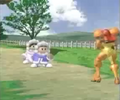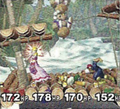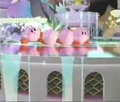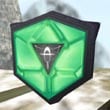Unused content (SSBM)
The following unused content is known from the development of Super Smash Bros. Melee.
Characters
Considered
- NES representative – Balloon Fighter, Urban Champion, Bubbles from Clu Clu Land, and an Excitebiker from Excitebike were among the potential candidates for a representative originating from the NES. Masahiro Sakurai eventually chose the Ice Climbers for this spot in the roster.[1]
- Wario - In response to a fan in a questionnaire on the Melee website, Sakurai stated that if he had the time to add one more character, he would have added Wario.[2] Wario was also the 3rd most popular character in the Smash 2 ballots and on the Japanese website.
- Lucas - Sakurai originally planned to replace Ness with Lucas, but ultimately decided against it due to the delay of Mother 3.[3]
- Ayumi Tachibana – During his appearance on Niconico on March 10, 2016 to celebrate his 500th Famitsu column, Sakurai stated that he considered Ayumi Tachibana from Famicom Detective club for the game, but did not include her as she lacked familiarity abroad.[4]
- Snake – During the development of the game, Hideo Kojima asked Sakurai if he could put Solid Snake in the game, but it was too late as the game was too far into development.[5]
- Sonic - Former head of Sonic Team, Yuji Naka, stated that Sonic was very close to be included in the game, but was not added due to time constraints.[6]
Others
Masahiro Sakurai answered fan questions in a questionnaire on the original Super Smash Bros. website, with some of them regarding the inclusion and exclusion of certain characters.
- Takamaru – Sakurai stated that a new The Mysterious Murasame Castle game and Takamaru appearing in Super Smash Bros. were both highly unlikely.[7]
- Mach Rider – When asked about what character he would like to include in the next Super Smash Bros. game, Sakurai stated he wanted Mach Rider to be in the game because he thought he had the "best name."[8]. He also stated that his generation usually wants characters from Mach Rider and The Mysterious Murasame Castle.[9]
- Rare character - Sakurai stated that it was difficult to include a character from Rare, such as Banjo and Kazooie, for various reasons.[10]
- James Bond - Sakurai stated that he did not include James Bond because he did not want realistic guns in the game, could not use the actor's likeness, the rights to the character are owned by Rare, and the copyright would not go through since the game is based on a movie.[11]
Stages
The game initially had only 10 starter stages, one for each of the default character universes except for Ice Climber: Princess Peach's Castle, Kongo Jungle, Great Bay, Brinstar, Yoshi's Story, Fountain of Dreams, Corneria, Pokémon Stadium, Mute City, and Onett.
Differences
- Rainbow Cruise - originally had considerably more clouds, a grayer sky, and a different ship design. No gameplay footage has been found of this early version of the stage.
- Jungle Japes - pictorial evidence shows some gray textures on the floor and a background similar to the finished stage.
- Great Bay - the laboratory on the main platform could be jumped on and walked inside of. In the final version, it is a part of the background. The platform at the right of the stage was initially composed of three metal beams instead of five. Additionally, a pot was present on the stage in debut gameplay footage.
- Temple - an elevator on the right side of the stage was present. Additionally, mysterious brown platforms appear throughout the stage; they don't appear in the final version, though they can be seen in the "Special Movie" video found in the game's Data menu.
- Yoshi's Story - the rightmost stage part was a plateau followed by a curved path up to another plateau and a walkoff blast zone. It also had various blue platforms. Curiously, they do not appear on most other shots or footage of the stage, indicating that they may have been moving platforms.[12]
- Yoshi's Island - was larger overall with more rows and a column of smaller-sized Rotating Blocks. It also featured three Note Blocks covering the middle of the chasm instead of three Rotating Blocks covering the chasm completely.
- Fountain of Dreams - had a simpler layout, with only two nonmoving platforms, similar to Pokémon Stadium's normal form.
- Green Greens - had a darker color scheme, uneven drop-though platforms, stone Star Blocks and main platforms, and a maximum of four Star Blocks per row over both gaps instead of three.
- Brinstar - the acid seemingly dealt much more knockback, KOing Donkey Kong at 114%. The bottom blast zone seemed to be much higher, and the acid could be seen closer to the platform before blocking the blast zone.
- Onett - played a considerably different arrangement of "Bein' Friends" from Mother.[13] The stage was initially called "Eagle Land: Onett" instead of "Eagleland: Onett."
- Fourside - originally had ordinary black-and-white buildings, rather than the buildings with multi-colored lights.
- Pokémon Stadium - screenshots showed that the screen in the background being blank, although it may not have been fully programmed. Later screenshots showed elemental icons displayed on the screen resembling those from the Pokémon Trading Card Game. Venusaur and other Pokémon were originally going to appear on the stage as well.
- Mushroom Kingdom - looked similar to the Mushroom Kingdom in the original Super Smash Bros., even including Warp Pipes that could be entered into.[12]
- Mushroom Kingdom (Adventure Mode) - footage shows the Ice Climbers and Samus appearing to be fighting in what looks to be this stage. It is normally not accessible in the final game; additionally, this version has a darker colored path, a fence, and considerably fewer trees. Of note is that this area briefly appears in an early version of the opening movie, and a slightly altered version can be seen in the final product's opening with Kirby briefly walking around in the area. This stage as the first stage of Adventure Mode also had different textures on the platforms and rocks, along with considerably more trees along the path.
- Icicle Mountain (Adventure Mode) - the original seal-like Topis from the Japanese version of Ice Climber appeared on this stage. However, the final North American and European versions of the game feature the yeti-like Topis from the North American and European versions of Ice Climber. This change is likely due to the controversial subject of seal clubbing, a highly volatile topic in North America and Europe that is effectively nonexistent in Japan.
Considered
- Sprout Tower - In response to a fan in a questionnaire on the Melee website, Sakurai stated that this was considered for a stage at the start of development.[14]
Scrapped
Through Action Replay, multiple stages from testing can be found via the leftover debug menu.
- TEST – a large, gray test stage with a background depicting a photo of Caffe Verona in Palo Alto, California, an image commonly used in OpenGL testing . The song "Corneria" plays on this stage.
- AKANEIA – a Fire Emblem stage named after the continent Fire Emblem: Shadow Dragon and the Blade of Light, Fire Emblem: Mystery of the Emblem, and Fire Emblem Awakening primarily take place in. This stage was going to feature dragons, mages, and even ballistae slinging stones at a castle. Even with hacking, no one has successfully accessed the stage.[15]
- IceTop / 10-2 - both are identical stages that load Icicle Mountain, albeit without the music. IceTop was planned to be a second Ice Climber stage,[16] and 10-2 was to be a second Ice Climber stage in Adventure Mode after 10-1 (the internal name for the Ice Climbers stage in the Adventure Mode). Loading this stage via the debug menu without additional hacking crashes the game.
- DUMMY - a black background with a lone invisible platform that can be made visible with the debug menu. Loading this stage via the debug menu without additional hacking crashes the game.
- TSEAK - Sheik's Target Test stage distinct from Zelda's. Remnants of the stage consist only of a single dark gray platform and three targets.
Gameplay
- In the gameplay and demos shown at E3 2001, the hitstun dealt seemed to be the same as in the previous Super Smash Bros., with a hitstun multiplier of 0.52. However, in the final game it was changed to 0.4, possibly due to the increased falling speed of each character making recovery too difficult with such a high level of hitstun.
- It may have been possible to up smash out of shield without using jump-cancelling.[17] Additionally, shields were much bigger and perhaps less susceptible to shield stabbing. This gives possible explanation for why Mr. Game & Watch's shield is so small compared to his body, as the shield sizes may have been haphazardly reduced in the final months of production.
- It is speculated that L-cancelling removed all landing lag from aerials, like in the previous Super Smash Bros., instead of reducing it by half.
- The instruction booklet had an image for the description for Stamina mode showing all four characters having over 150 HP of Stamina, which cannot occur in normal gameplay. Players in a Stamina match always start with 150 HP, and this value cannot be edited without the use of a hacking device.
- Early screenshots show that damage percentage font remained white instead of reddening and eventually blackening with climbing percentages.
- The Special Movie shows characters in gameplay with sound differences. In one clip, Mario exclaims "Wah!" upon picking up a Hammer, but in the final game, none of the characters vocalize when they pick up the hammer. Peach had a few voice clips appeared to be voiced by Leslie Swan instead of Jen Taylor. In Bowser's vignette, Peach yells "Yahoo!" while throwing a vegetable at him, which does not occur in normal gameplay. During the ending clips showing all the characters, Peach's clip features her taunting, with her saying "All right!" instead of "Sweet!" Pikachu was silent while charging Skull Bash. An unused shout from Popo while performing Blizzard can be heard during the ending montage.
- Early screenshots, footage, and the Special Movie show that characters, if selected by more than one player, could use the same alternate costume. Unlike in Team Battle, however, there was no change in contrast. This also assumed to be done purposefully using debug mode to film the Special Movie.
- Captain Falcon's Blood Falcon alternate costume originally had "Hell Hawk," the Japanese name of Blood Falcon's vehicle, written below the Blood Falcon emblem on its back.
- The Special Movie shows certain differences in characters' moves. Captain Falcon's Falcon Punch is seen to be as fast as it was in Super Smash Bros., and his taunt was initially not animated as smoothly. Kirby's Vulcan Jab combo did not feature small projectiles in front of his hands. Link's Bow did not glow upon being fully charged.[18]
- Donkey Kong gradually descended while performing Spinning Kong in the air instead of gaining some altitude.[12]
- The first shot in a series of rapid shots from Fox's Blaster dealt hitstun in addition to damage, instead of only dealing damage like the rest of the shots. Fire Fox seemed to cover a shorter distance. His Reflector could seemingly be landcancelled like in the original Super Smash Bros.,[19] but it is unknown if this means that it could not be jump cancelled as well.
- Knocking a Goomba in the Adventure Mode caused a screen shake effect.
Here all four players have the same alternate costume, which is impossible in normal play.
- Beta Falcon Punch- 2015-04-27 14-47.gif
Falcon Punch with its speed from the original Super Smash Bros. as seen in the Special Movie.
Items
- The Proximity Mine from Perfect Dark replaced the Motion-Sensor Bomb item from GoldenEye 007, but this change was ultimately kept only in the Japanese version of the game.
- The Pokémon Ditto was supposed to appear from Poké Balls, turning into the summoner's character and assisting them in battle. It was removed, though it is still left over in the Debug menu; when summoned, however, it simply says "Mon-mon!" (after its Japanese name "Metamon"), spins while stretching vertically, then disappears. Ditto appears in the game's official strategy guide, stating that "Ditto will Transform into the player who threw the Poké Ball, then join up with him or her for a short time."[20]
- The Pokéball Pokémon Electrode originally did not darken before using Explosion.
- Summoning items analogous to Poké Balls called "Assist Capsules" were planned for Melee but were dropped, later appearing in Brawl as Assist Trophies.[21]
- For a short time, the bonus information related to Sukapon was accidentally posted on Melee's website. Sakurai mentioned that Sukapon from Joy Mech Fight was cut because of "adult matters," and that players would have been able to ride Sukapon as an item.[22]
Menus
- Certain menu selections, specifically the Trophies, Options, and Data selections in the Main Menu (then-called "Top Menu"), as well as the Special Melee selection in the Vs. Mode menu, were all blanked out with "?"s. Furthermore, the panel to the right of the menus previewing the menu of the currently selected menu selection, looked considerably different.
- The Lottery interface had a radically different design, with the actual machine being considerably larger and featuring a model ship, roulette wheel and craps table in the background.
- The earliest character select screens aligned the character portraits to one side. Each of these screens featured less than 14 character portraits. Additionally, similar to the original Super Smash Bros. beta character select screen, the words "Battle Royal" were displayed in the top left corner instead of "Melee." Finally, the "Press Start" banner on the "Ready to Fight!" band was not located on the banner and instead just above the player boxes.
- Later versions of the character select screen close to the game's release looked nearly identical to the final product. One image on the Japanese website shows Zelda's character portrait covered by a "?" mark, like other secret characters. As Sheik's playability was revealed before Zelda's, the move is speculated to avoid spoiling the surprise of Zelda's playability. This screenshot also shows that the Ice Climbers' Japanese name was hyphenated.
- The stage select was formatted differently, with Brinstar placed on a top row and Corneria being in the middle. "?" portraits were also in place of presumably the two Special Stages and three Past Stages.
- All-Star Mode was intended to have intro screens nearly identical to the ones found in Classic Mode. They were ultimately unused, with the mode ultimately using the All-Star Rest Area in transitions between fights, though they are still fully accessible in the Debug Menu.[23] The earliest Classic Mode intros also looked vastly different from the final version's, featuring different character artwork and no maps or backgrounds. However, Bowser's Classic Mode render remained the same but was positioned more towards the background, and so appeared slightly smaller.
An early version of the Lottery interface.
Trophies
- Early screenshots showed the Proximity Mine from Perfect Dark trophy in place of the Motion-Sensor Bomb trophy from GoldenEye 007 in the final version of the game. This change was retained only in the Japanese version of the game. A screenshot of this Proximity Mine's trophy also shows that the text is almost identical to the Motion-Sensor Bomb's, save for a few references to the Carrington Institute, an area in Perfect Dark, and the listing of Perfect Dark as its game of origin instead of hiding it with "TOP SECRET." It is unknown why this is the case.
- Early versions of the game featured the original seal-like Topis from the Japanese version of Ice Climber as a trophy. However, the final North American and European versions of the game feature a yeti-like Topi from the North American and European versions of Ice Climber as a trophy. This change is likely due to the controversial subject of seal clubbing, a highly volatile topic in North America and Europe that is effectively nonexistent in Japan.
- Fire Emblem trophies were planned to be included in the game, but they were too complex to make.[24]
- Trophies from games by Rare Ltd. were planned to be included in the game, but they were dropped.[25]
- MeleeMotionSensorBeta.png
Super Smash Bros. Melee's original Motion-Sensor Bomb trophy.
- Topitrophy beta.jpg
The original Topi trophy.
Bonuses
Some Bonuses were left out of the final game, though they can be accessed with an Action Replay. The reason for their removal is unknown.
| Name | Points Given | Requirement |
|---|---|---|
| Barrel Blast KO | x300 | Used a Barrel to KO someone. |
| Crash & Burn | -500 | All Meteor Attacks Missed. |
| Deflector | 1000 | Unknown (presumed to be something to do with reflecting attacks) |
| Green Shell Shooter | x800 | Caused damage twice or more with a Green Shell. |
| Poolshark | x300 | Threw one enemy into another. |
| Red Shell Shooter | x400 | Caused damage 3 or more times with a Red Shell. |
| Ricochet Rifler | x800 | Deflected shot hit an enemy. |
Box art
The original boxart depicted Mario getting attacked by Bowser with his Fire Breath instead of showing Mario, Bowser, Link, and Pikachu fighting. The lighting on Hyrule Temple was also considerably brighter. This box art was used for some of the game's early promotional material, including websites accepting orders for the game, and some print advertisements, and retail catalogs.
- BetaBoxArtMelee.jpg
The original Melee box art.
See also
References
- ^ http://www.nintendo.co.jp/n01/n64/software/nus_p_nalj/smash/flash/1009/index.html
- ^ http://www.nintendo.co.jp/n01/n64/software/nus_p_nalj/smash/flash/syukeiken/return512.html
- ^ http://www.nintendo.co.jp/n01/n64/software/nus_p_nalj/smash/flash/0717/index.html
- ^ https://www.youtube.com/watch?v=x4HvNnUaH08&feature=youtu.be&t=4557
- ^ http://www.n-sider.com/contentview.php?contentid=2576
- ^ https://www.youtube.com/watch?v=jK1Kp679FGc&feature=youtu.be&t=1899
- ^ https://www.nintendo.co.jp/n01/n64/software/nus_p_nalj/smash/PostReturn025.html
- ^ https://www.nintendo.co.jp/n01/n64/software/nus_p_nalj/smash/PostReturn049.html
- ^ https://www.nintendo.co.jp/n01/n64/software/nus_p_nalj/smash/PostReturn003.html
- ^ http://www.nintendo.co.jp/n01/n64/software/nus_p_nalj/smash/flash/syukeiken/return506.html
- ^ http://www.nintendo.co.jp/n01/n64/software/nus_p_nalj/smash/flash/syukeiken/return526.html
- ^ a b c https://www.youtube.com/watch?v=9exe4q9ykaQ
- ^ https://www.youtube.com/watch?v=mVel6eQP-xg
- ^ http://www.nintendo.co.jp/n01/n64/software/nus_p_nalj/smash/flash/syukeiken/return520.html
- ^ https://www.nintendo.co.jp/n01/n64/software/nus_p_nalj/smash/flash/syukeiken/return527.html
- ^ http://www.nintendo.co.jp/n01/n64/software/nus_p_nalj/smash/flash/syukeiken/return554.html
- ^ https://youtu.be/RK-RqQTEppw?t=7m36s
- ^ http://www.nintendo.co.jp/ngc/galj/movie/galj_ml1.wmv
- ^ https://youtu.be/RK-RqQTEppw?t=6m43s
- ^ http://www.sourcegaming.info/2015/04/13/the-definitive-unused-fighters-list-in-smash/#%5BMelee%5D
- ^ https://www.nintendo.co.jp/n01/n64/software/nus_p_nalj/smash/flash/syukeiken/return537.html
- ^ http://www.nintendo.co.jp/n01/n64/software/nus_p_nalj/smash/flash/syukeiken/return510.html
- ^ https://www.youtube.com/watch?v=NGOzsSEBO9Y
- ^ http://www.nintendo.co.jp/n01/n64/software/nus_p_nalj/smash/flash/syukeiken/return569.html
- ^ http://nintendoeverything.com/rare-not-upset-that-nintendo-didnt-request-conker-banjo-in-smash-bros








































